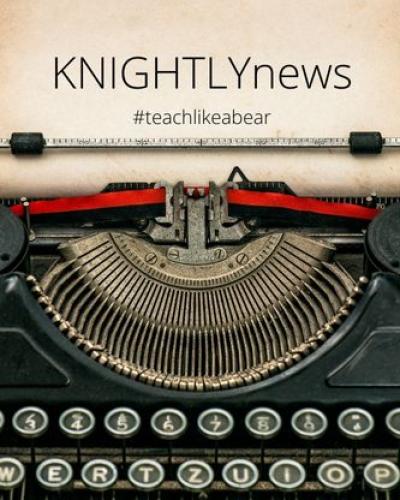The KNIGHTLYnews is an online forum where FWS instructors and other teachers of writing can swap and share ideas for best classroom practice. Weekly posts are designed to help teachers develop lesson plans and writing assignments, and respond to classroom challenges by introducing new teaching tools and sharing emerging pedagogical ideas. Posts also direct readers to program and campus resources that support teaching and learning, and provide opportunities for peer collaboration and mentorship.
Last month, my colleague, David Faulkner, shared the exciting ways he uses role playing to inspire peer review work. In his FWS on Jane Austen, he assigns students roles as different Bennet sisters to prompt playful and differently motivated responses to classmates in small peer review review groups. (Role-Playing Peer Review) In my own classes, I have asked students to respond to papers as they imagine authors of our assigned readings might -- and challenge them to channel their chosen authors' tone, style, disciplinary perspectives, and points of view as they respond to their peers' drafts. The possibilities are endless!
In this post, I offer a handout that can add another layer to your peer review session. The handout addresses the question: On WHAT should students (in or out of assigned roles) comment when responding to each others' drafts?
Note that my prompts do not necessarily encourage evaluative feedback. Rather, they guide students to notice essential textual features and describe what they see in each others' drafts -- in an effort to pull them toward productive discussions about academic writing and a range of possibilities.
__________
PEER REVIEW WORKSHOP HANDOUT
Logistics
For this activity, break into groups of 2 or 3 and exchange drafts with each other.
Greetings & Reflection
Before you begin reading and commenting on each others' drafts, take just a few minutes to introduce yourselves and to discuss the following questions:
- What’s one thing you think you did really well in your draft?
- What’s one thing you could not quite figure out or are unsure about?
- How do you want to receive feedback – orally or in writing?
Read & Respond
Take turns reading on each others’ drafts.
After you read, respond to the writer's comments: How can you help the writer build on their strengths to address their concerns about weak or unfinished areas in the draft?
Here are some prompts to help you target specific areas of interest and concern.
Select no more than 3 prompts to work on today with your peers. Which among the 9 below seem more pressing or promising?
Note that we will return to this activity several times before you submit your final draft, so you will have opportunities to receive feedback on all 9 of the prompts below. Today, you will decide where to start and what to prioritize.
Ideas for Guiding Comments
Introduction (Beginning of the essay)
- Does the writer frame and name the essay’s TOPIC/FOCAL POINT? Provide a ONE sentence summary of the essay’s topic.
- Does the writer clearly identify a MAIN CLAIM? State the main claim in your own words.
Body Paragraphs (Middle of the essay)
- How does the writer use source materials to build claims? Identify the sources and describe the relationship the writer builds with each.
- Does the writer capture the essence of each referenced text as a whole for a reader who’s never read it before? Note ONE additional piece of information that someone might need to know.
- Highlight and contemplate the verbs used after each source’s name. ("Freidman says," "Freidman writes," "Freidman disputes," "Freidman cites." (Click here for more ideas from the writing center at Xavier University.) Comment on how well the writer captures the work of the cited passage and offer a revised verb if one seems more accurate, precise, or effective.
- Does the writer provide enough support for the claims made in each body paragraph? Note ONE additional piece of information that might usefully develop the paragraph.
Conclusion (End of the essay)
- Quickly review the first and last sentences of each body paragraph. Now re-read the essay’s conclusion. Does the writer synthesize the essay’s key points in the final paragraph section of the essay? Note any missed opportunities to remind readers about the essential work of the essay’s middle section.
- Quickly review the introduction. Now re-read the essay’s conclusion. Does the writer fully address the problem and argument presented at the beginning of the essay? Note any opportunities to pull the essay into tighter focus.
Technique
- Highlight 2 sentences in your peer's draft:
- CLAP -- What one sentence do you consider the most powerful? Give it a CLAP because it captures a smart idea and/or presents it succinctly or elegantly.
- LOL -- What one passage made you Laugh Out Loud (and not because the writer meant it as a joke)? Give it some LOVE -- we all write those sentences that get away from us -- perhaps they include an amusing typo, or more likely an idea just got lost somewhere between the brain and the keyboard.
Reflect on Learning & Set Goals
When you finish your work with each others' drafts, jot down a few sentences at the bottom of the draft (just for the writer) or in the table below (to share with the class):
- After reading your peers' drafts, what ONE thing did you learn about writing academic arguments and what ONE thing do you want to try out or do differently in your next draft or assignment?
|
Name |
Reflection |



